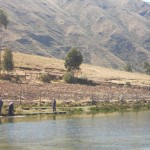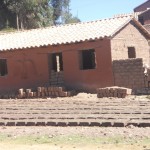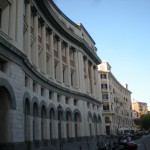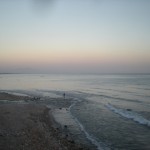Search Results for "rome"
Glaciers!
When I decided to go to New Zealand, it was on short notice, with very little research.  I was filling in, so I hadn’t studied maps or routes. I had, however, visited the Polynesian Cultural Center in Hawaii, and seen all of the Lord of the Rings movies several times. This gave me the impression that I would find amazing, tattooed warriors playing rugby with elves. This wasn’t entirely true.
One thing I didn’t realize is how close the South Island of New Zealand is to Antarctica. This geo-position became more and more clear as we drove further south. Lush forests and tropical-looking plants remained, but now they gave way not only to mountains, but to glaciers. Glaciers!
Yes, I’ve been to Glacier National Park. I’ve walked out onto the snow and ice, next to lounging mountain goats. But something about New Zealand is more. Not the way Rome is more with its lights and bustle. Not the way Texas is more with its big. New Zealand is more in its ruggedness. It feels like the wild west. Like driving our little campervan around the country was an expedition. As though we could, at any moment, discover a velociraptor in the undergrowth.
Our first stop for glacial admiration was the Franz Josef glacier.  We drove into the park, past signs that told us where the glacier was 200 years ago, 100 years ago, 25 years ago, and into a lot full of vans. As usual, ours was the most interesting – save the ICEBREAKER van parked down the way!
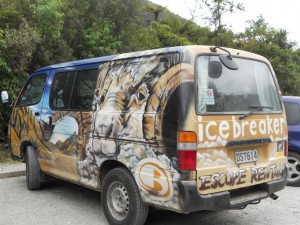
I flashed a smug smile, counting how many layers of the merino sweaters I was wearing as we passed, entering a thick canopy of dense trees.
The alder enveloped us, tall, thin trunks reaching up, covered in the white lichen that indicates extremely pure air. Stepping out a short while later, we found ourselves faced with a naked, scouring wind rushing across the glacier and down the valley. And opposite us, the glacier.
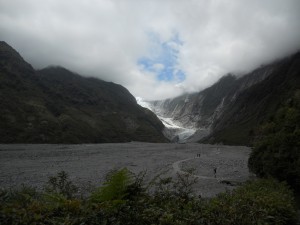
The trail took us out across the glacial valley, over the rocks ground down and deposited by the retreating ice. Waterfalls surrounded us, falling gracefully and freely from the steep valley walls, creating micro vistas of startling beauty.
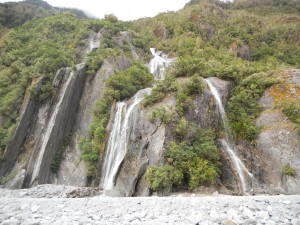
As we approached the glacier took shape and color, transforming from black and white to shades of blue.
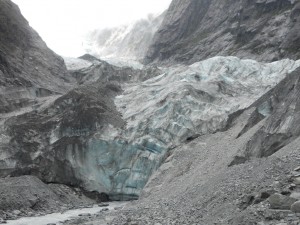
A rushing sound intensified, now less the sharp lines of the wind, and more the rock-shaped sounds of water moving hard, pushing up from the bottom of the glacial face.
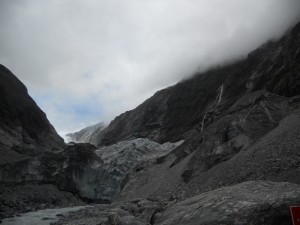
The water was nearly unnoticeable until we got close. It was the color of the rocks, its shape masked as it ran through the rubble, following a course that appeared haphazard, ready to change at a moment’s notice. Posted signs gave testament that the glacier could, in fact, change itself and the river in a metamorphosis of rock and ice gushing forth into the valley.
Sufficiently awed, we turned back to the trail.
Though our next destination was the Fox glacier, we took a recommended detour to a nearby lake known for its amazing reflected views of the surrounding mountains. Though the trail was littered with interesting flora, the lake itself was unyielding. The clouds had come in, leaving no mountain views, and perhaps the only less-than-perfect weather day of the entire trip.
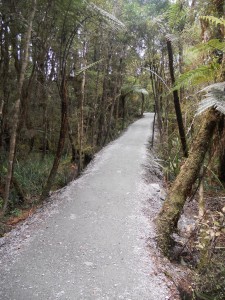
We acknowledged the excellent fern trees and made a run for the car as drops began to fall from the sky.
By the time we reached Fox Glacier, the rain had cleared, leaving a foggy residue clinging to the edges of the valley.
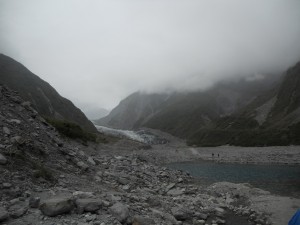
While our last lake experience had been a bit of a disappointment, Fox brought us a watery surprise.
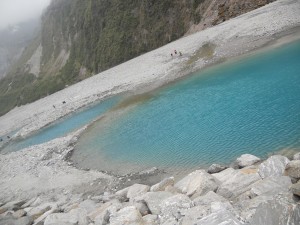
Lakes, eerily blue, greeted us at the trailhead, our first experience of the glacial blue waters of New Zealand.
This glacier allowed us closer, more textured views.
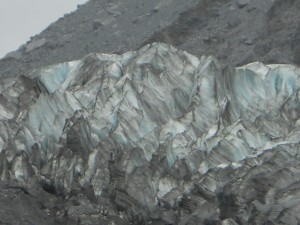
The experience was cold and stark and strangely peaceful. Which was good, because 20 minutes later we found ourselves running from swarms of sand flies on the West Coast. Literally running.
January 6, 2011 Comments Off on Glaciers!
Archeology
I don’ t know what I expected to find in Peru, other than a long trail and a big-ass set of ruins at the end. I expected alpaca, llamas, guinea pig. I didn’t expect to find archeology everywhere. It reminded me of Athens, and Rome, the ancient mixed with the modern, built on top of, making itself seen in flashes of stone.
Our second day in Cuzco, Kelly suggested that we see some of the archeological sites in the surrounding valley.
“You can take a cab up to the highest of the four sites and then walk back. It’s like 7 miles. We can do that, right?â€Â We were pretty sure that we could. LeAnna and I were heading out the next day for the 4-day Inka Trail trek. And Kelly was recovering from an Achilles injury. The question was more whether we thought it was a good idea.
“I’ll go ask the front desk about it.â€Â Kelly headed downstairs while LeAnna and I took turns showering and getting ready for the day. When she returned, it was with a big smile on her face.
“It’s $5 for the taxi…and she said we can rent horses!â€Â We stopped pawing through our backpacks and looked up at her beaming face.
“Horses?â€
“Yes! You can ride horsed back down. Should I ask her to call a cab?â€
An hour later we were climbing into a hatchback, the three of us crammed in the back seat, grappling with the stubborn seatbelts.
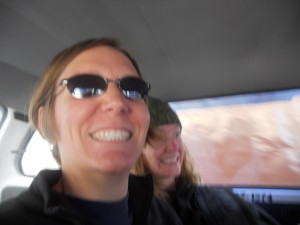
The driver wound through the too-small streets, rattling along the stones, as people jumped out of the way onto sidewalks or up into doorways.
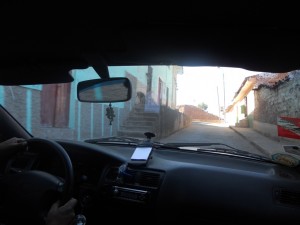
As we drove up and out, we were treated to a view of the city, nestled in the hills high above the distant sea.
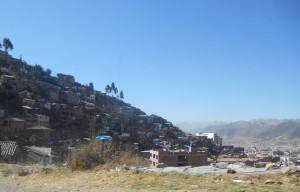
Here we found locals. Real ones. Dressed in the functional clothing that kept them both warm in the morning chill of 12,000 feet and safe form the uv rays of the sun, relatively unfiltered by the thin air.
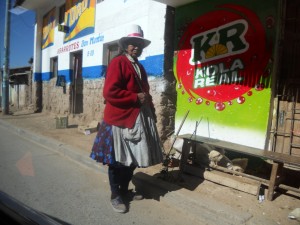
Our taxi driver dropped us at the topmost of the four sites we would see: Tambo Machay. We were greeted by dreadlocked donkeys and llamas rolling in the grasses.
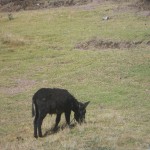
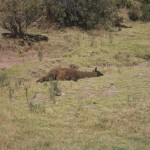
The focal point of this site was water. From the spring running along side the path leading to the ruins, to the incorporation of the water in the beautifully hewn stone, there was no question about its importance here. Beautiful trees grew on the banks of the little spring, shading the path, providing a rare bit of shade. Despite the biting chill in the air, we lingered out of reach of the sun’s searing rays.
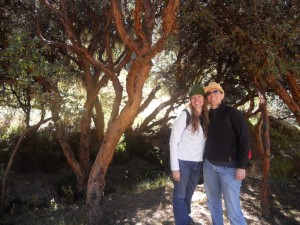
Merchants walked the path, back and forth from a make-shift marketplace at the foot of the ruins, carrying their wares and offering pictures with their livestock.
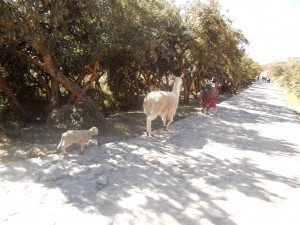
The archeological site was beautiful. The stones were smooth and impeccably placed. The thousand years or so of weather only a mild nuisance to its grand presence. The aqueducts were clearly deeper than they had been when they were originally cut into the rock; worn away by centuries of flowing water.
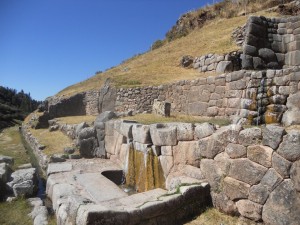
The niches, possibly used to display mummies – a connection with the afterlife – still retained their pink hue, and sharp angles.
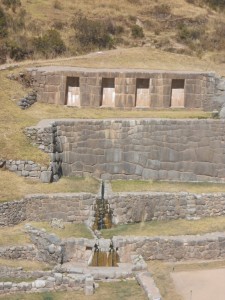
We climbed to a viewing area and surveyed the site. Locals gathered water from the spring, the market spread out in a colorful patchwork of textiles, and a shepherd brought his sheep along the ridge just above the site, the modern mixing seamlessly with the ancient.
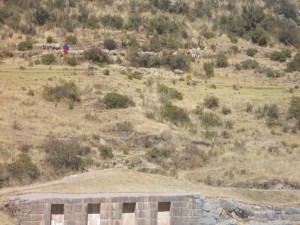
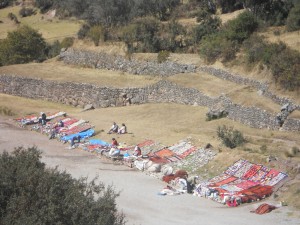
From Tambo Machay we walked down the winding road that had brought us from the city. Our next stop, Puca Pucara, was just across the way, a sentinel balanced over the valley.
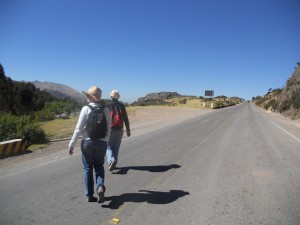
If Tambo Machay was about water, Puca Pucara was about the earth and air. Wind whistled around the site, open on all sides to the elements.
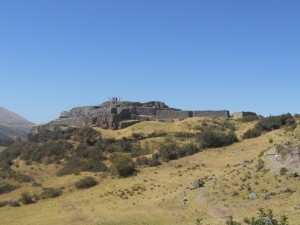
When we walked up we found a young man and woman who wanted to show us the site. “Just for tips.â€Â We declined, but I was intrigued. “Without knowledge, this is just a pile of rocks,†he called after us. We had our guidebook, but his words stuck with me. How interesting that we had traveled all this way to see a pile of rocks. To walk on a pile of rocks that had been so carefully placed. How curious.
On the inside we found carefully constructed windows, small niches, walls built in harmony with the rocks upon which they stood.
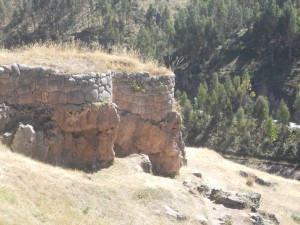
And a cave. LeAnna found the little opening, and we contemplated the intelligence behind entering. None of us had brought a head-lamp, which, in the end, probably saved us from making a foolish decision.
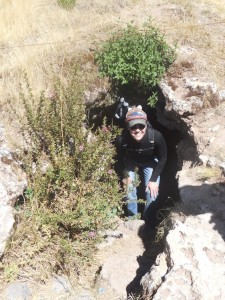
The thorn bush and stinging nettle pleaded with us to turn back. Which we did.
The site had a good number of rooms, layered on top of each other. We climbed stairs cut into the mountain, and spent time looking out at the valley. It was clear that this site was placed so as to offer a view, whether for aesthetic or military purposes. In fact, its purpose as either a hunting lodge or a fortress is still in question.
This was our first introduction to a couple of things. First, the small, uniform niches that decorated the inner walls of the sites. They were perfectly sized to house me.
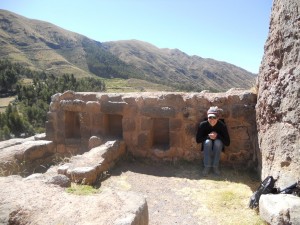
Second, we were introduced to the mountain-shaped rocks carved by the Inka, sacred objects that we would have walked by without knowing they were there. This stone at Puca Pucara was shaped like the entire site of Machu Picchu.
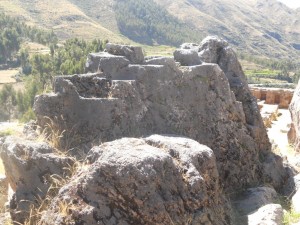
As we walked from the site, Kelly started to feel the uncomfortable crisp that was beginning from spending hours in the high-altitude sun. Even her stylish straw hat provided little protection.
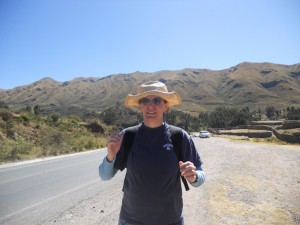
A quick reassignment of clothing resulted in a charming expedition-worthy outfit.
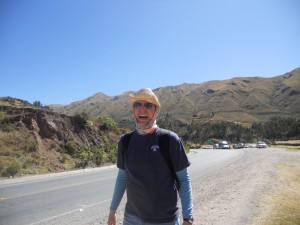
I think that one of the greatest parts of traveling with other people is that I don’t have to be the only one to look like a fool on a regular basis.
The walk between Puca Pucara and the next site of Qenko was the longest leg. We passed a wildlife refuge (about an acre of flooded grassland), fields of great clay bricks drying in the sun, and animals of all sorts.
My favorite was a pig, ridiculously tethered to a clump of grass.
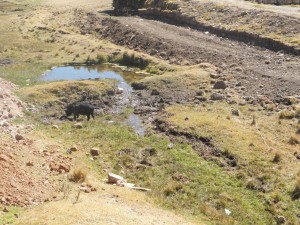
As we turned a corner, the road swinging wide out over the valley, we saw a pack of horses, and two men sitting in the grass. We all smiled and waved. We’d nearly forgotten about the horses! A quick negotiation, and we were on horseback, our guide walking beside us.
My horse was Palomo. A beautiful, dusty white guy who was assigned to me, after I volunteered that I’d ridden before.
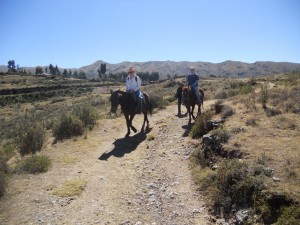
The ride was great. We meandered through the hills, cutting across the country-side, up and down rocky embankments, and splashing through wild springs.
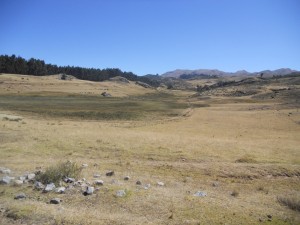
Kelly chatted in Spanish with our friendly guide, and I tried to slow Palomo who clearly preferred to run ahead of the pack. Only once did we stop, our guide ordering me off of the horse, and instructing Kelly and LeAnna to continue on. They looked at me and stayed put as our guide walked over to Palomo and adjusted the saddle, which had slipped back considerably.
With graceful movements, he adjusted the straps and moved with the horse when he sensed the argumentative kick coming.
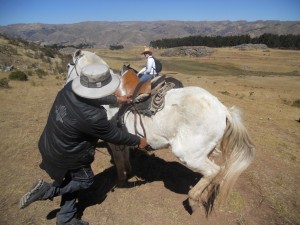
As we neared Quenko, our guide gave us the go-ahead to let the horses run. That was what I’d been waiting for. All thoughts of a slipping saddle were thrust aside as I nudged Palomo on.  And we flew, through the hills of Peru, a huge smile on my face, and a chortling rumbling up from my soul. Up the hill and into a lane filled with other horses, and we landed, Palomo taking charge of where and when to stop.
We hopped down, said our goodbyes and headed up the lane in the direction our guide pointed. We were in a distinctly agricultural area now. Workers were bringing tubs of potatoes from the fields to dry in the sun.
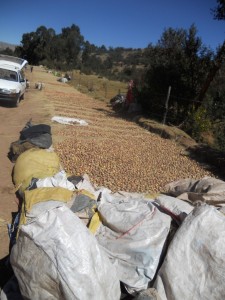
We spent the next while at Quenko. It was lunch time, and we made a familiar picnic of trail mix, dried peaches and cheese. The horses had been a delightful break in the day and we were all smiles as we hydrated and rested our thighs.
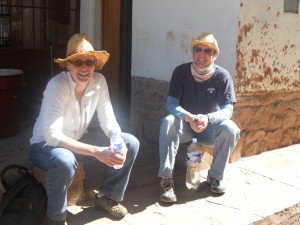
This site was different from the others. It was carved into the rock. Zig-zag channels and natural crags replaced the carefully-formed walls of the other sites. We walked along the path to the site, noting the differences.
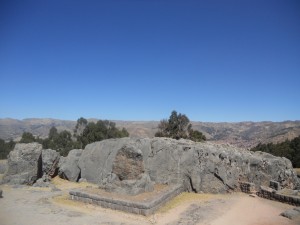
And then we were in the ruins. Literally, in them. Quenko was all about the earth. The great cave in its center was a clear focal point. The altar, carved from “living stone†is thought to have been used for embalming. Mummies were an important part of Inka culture, serving actively as a connection between this world and the next.
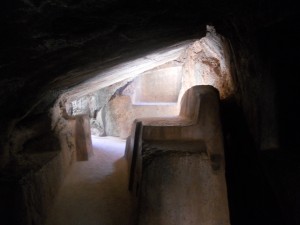
Between the altar and the niche at the far end of the chamber was a great crevasse. LeAnna and looked up at the piece of sky above, and the clear path to the surface. And then we jumped. She did a neat tuck and roll away from the edge, gently sloping down into the bottomless earth. I made a comment under my breath about not having health insurance. Halfway through the muttered doubt, I slammed the edge of my knee into the edge of the unforgiving stone. One day before the longest trek of my life.
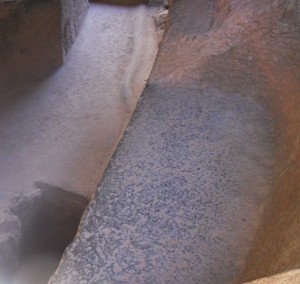
Even with the purple bruise already blooming, I was able to walk, so I shook it off and looked back, thankful that I was above, and not an offering to mother earth.
Up above, we met a young man anxious to talk with us about the site. Not for tips. He introduced himself and his culture and told us he was preparing to be a shaman.
“In two weeks.â€Â He had that long to prepare. He’d been coming to the site every three days for the last 6 months or so, and was ready to join his father, grandfather and great-grandfather as a shaman.
“That is a good sign for you,†he said pointing to two small butterflies that were fluttering together 5 feet from the ground.
He pointed out the phallus-shaped site visible from where we stood – the companion to the uteral cave we’d just escaped from – as well as the male and female mountains visible from where we stood.
We thanked him and walked back to the road. Without horses to guide us, we chose the road that seemed to be headed most directly down and began our journey to the final site. We walked past houses and fields, llamas and soccer goals.
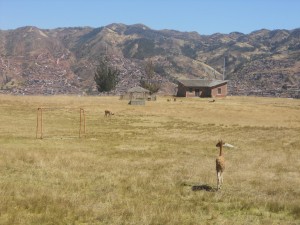
Sacsayhuaman (pronounced “sexy woman”) our final site for the day, was the largest, by far. The Cuzco region is said to be shaped like a puma. Sacsayhuaman is known as the puma’s head. The walls of the site form jagged, tooth shaped battlements – the puma’s mouth. Even from a great distance, it was easy to see why.
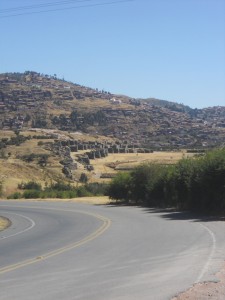
The road took us out of the way, through a small resort, and next to more llama pastures. As we walked past one, a herd of llama escaped, running through an unsecured gate. We considered whether we were morally obligated to attempt to wrangle the llamas.
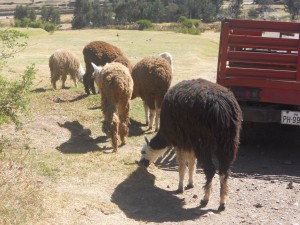
We decided, no. We were not.
Once at the ruins, we found a spot in the shade to relax and hydrate.
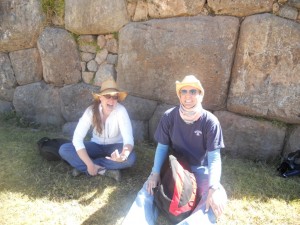
And to take in the enormous Cristo Blanco standing opposite the ancient Inka site.
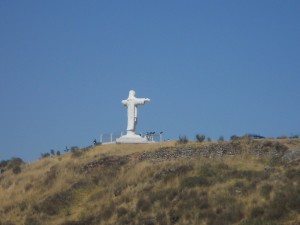
The site was gigantic. We spent at least an hour there and saw a small fraction of what there was to see. The stones that were used were incomprehensively large. One was something like 70 tons.
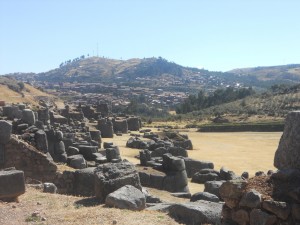
We wandered through the doorways, up the steep stairs, along terraces.
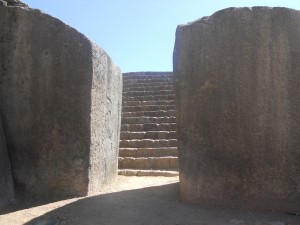
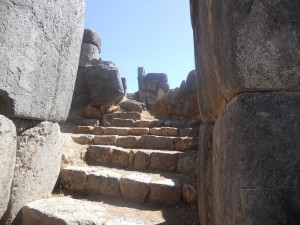
We contemplated the strange, chalk grids marked on the walls, designed to help reconstruct the site in the case of an earthquake.
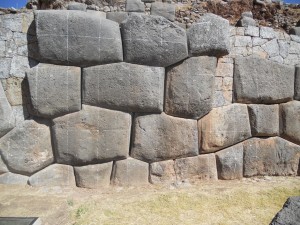
I also perfected my Peru look.
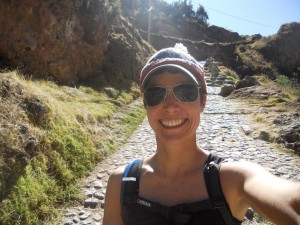
The hat kept me warm, the camelback kept me hydrated, and the tank let me get some sunscreened rays.
And then we went in search of the old Inka trail that our guidebook said we could take form the site down into the city itself. But there were a lot of stone trails. Eventually, we chose one that we thought looked promising, and headed down hill on the worn stones.
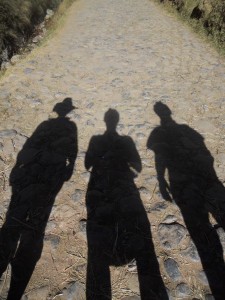
We made our way back into Cuzco, alongside the stray dogs that inhabit the streets. Along side the tiny, old women walking the sidewalks, and the insane motorcycles carrying propane tanks strapped to their metal frames. We walked back into the city with a boy and his grandfather carrying loads of rubbish on their backs.
We walked back into the city and directly into a pizza place.
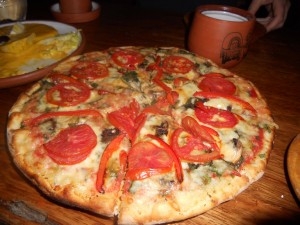
Along with the excellent pizza we had what became our favorite meal, avocado relleno.
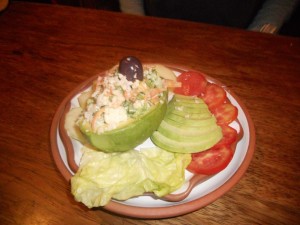
One of the vegetable dishes that we could eat, the avocado relleno was stuffed with boiled vegetables and cheese. It was delicious.
We also sampled a local potato and egg-sauce dish that wasn’t shabby, even if we weren’t exactly sure what we were eating.
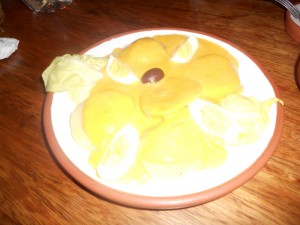
And we each had a local beverage. LeAnna opted for some kind of juice, Kelly for hot chocolate, and I won out with a huge mug of coffee, served concentrated with a beaker of hot water.
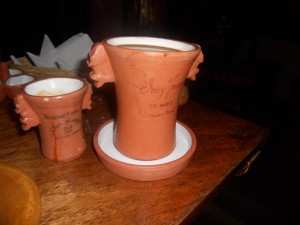
While we ate, the World Cup played in the background. Locals leapt up periodically to cheer on a particularly good play. We spent the rest of the evening doing laundry, walking the Plaza Armas, and in a briefing for the next day’s Inka Trail trek. But generally we were waiting until it was dark enough for us to return to the cake shop for dessert.
Which we did. It was good. I even ate a cheese sandwich. And I think we shared four desserts. But we’d been walking and riding and learning all day, so we were hungry.
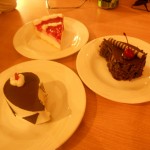
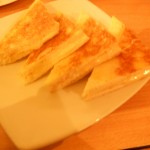
With full stomachs, we went to bed early, ready to wake up at 4AM and catch our shuttle to the Inka Trail, and our next adventure.
August 24, 2010 1 Comment
You gonna eat that?
Despite the fit that Venice threw while we were there, we managed to find some serious food.
Even in the storm, I was able to find my favorite restaurants. Whether it was Grom for incredible, fresh gelato,
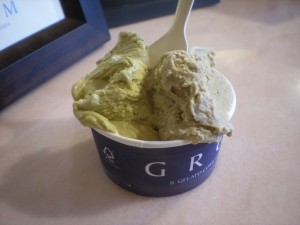
or Pizza al Volo for the best veggie pizza ever,
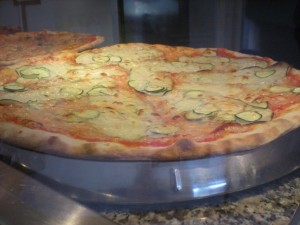
my old haunts materialized before us. I was even able to find the most remote of my previous dinner places on the first try.
Trattoria della Madonna is marked by a big, green lantern. As I went to tell the Ant this, I found myself looking at it.
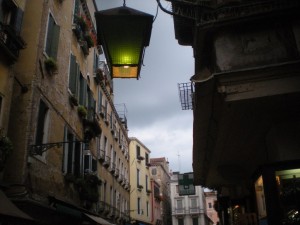
Like last time, I found the Madonna an elegantly simple restaurant.
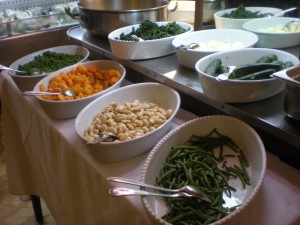
Serving seafood specialties and seasonal vegetables, I find it a delight to point my waiter in a direction – vegetarian, meat, fish – and let him bring something good.
Tonight, we had a great dinner of Bolognese and pasta e fagioli
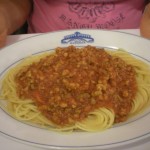
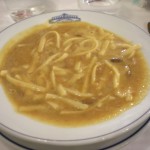
And snapper (it came whole and was boned for the Ant) and veggies.
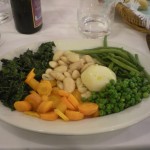
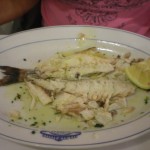
The Ant loved her snapper, and I was unable to finish the huge plate of vegetables. Though I stuffed as many of the carrots, peas and veiny beans down my throat as I could.
And then I ordered dessert.
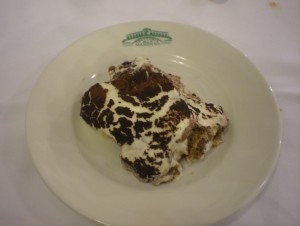
Not because I was hungry, but because you can’t really go to the alleged birthplace of tiramisu and not have it. Can you?
I think I cannot.
Regardless, it was a good first night of food. But we had another. After considering the menus of both Casi nobili, and Ristoteca Oniga, we decided to go with Oniga for our second night of food.
Oniga is a really warm place.
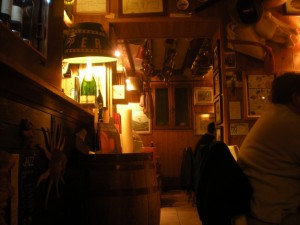
It glows with hospitality. I sat next to the owner’s Staffordshire terrier, asleep in her bed.
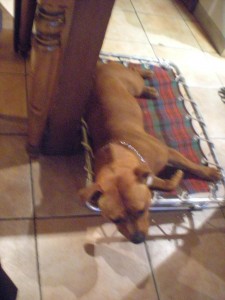
And we were soon in conversation with the two couples on either side of us. Of course, it helped that we were crammed in like sardines, but still. While we considered the menu, we shared travel tips and recommendations for food. The Ant and I found ourselves the resident experts on Venice, Rome and Siena, and we were glad to share what knowledge we had with our dining companions.
Tonight, I settled on a giant gnocchi and the Ant on a spaghetti with clams.
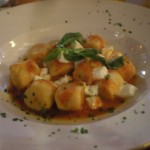
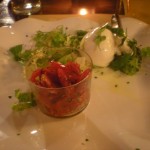
The gnocchi were the exact right firmness, even though they were twice the size of any gnocchi I’d ever had. And the sauce was a lovely, delicate blend of tomato, basil and bufala mozzarella – three of my favorite things.
The Ant raved about her spaghetti, and we passed along the recommendations to our friends around us, who were asking how it was.
Next came another whole fish for the Ant, and something the waiter had thrown together for me.
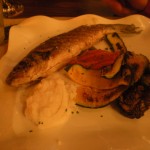
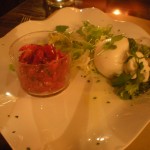
It was cheese. More bufala mozzarella. And the most absolutely astounding tomatoes I think I’ve ever had. I’d guess they were plum. Maybe Roma. But they were sweet and dressed with balsamic. Really good balsamic vinegar. And there was a dollop of fresh pesto. I made little stacks of cheese, pesto and tomatoes piled on bread.
And then I ordered dessert again.
A meek bus girl came over to take our plates, and asked if we wanted something sweet.
“What do you recommend?† I asked in some kind of Italian that she recognized.
“Ciocolata,†she smiled enthusiastically. I nodded and settled in, eager to see what she would bring.
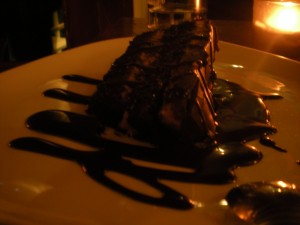
Yeah, it was chocolate. Cake. With some kind of maybe creamy-nut filling. And fudgy frosting. And a drizzle of chocolate sauce.
This, my friends, is why I ask for recommendations.
The Ant leaned over to one of the couples, and I leaned over to the other.
“You have to order this. No, I don’t know what it is. She just said, ‘ciocolata’.â€Â They all nodded and thanked us for the recommendation.
We finished up our little espressos, paid the bill, said goodnight to the dog and our new friends, and headed out into the night, to our little room a couple of blocks away, jacked up on caffeine and sugar, and blissfully exhausted.
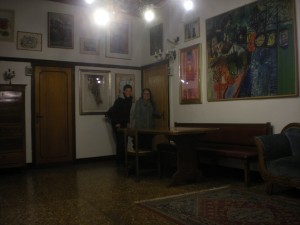
July 7, 2010 3 Comments
Mistaken
Our last, major excursion in the south was to the isle of Capri. Accent on the first, people. CA-pri. There you go.
Honestly, I’m not a huge fan. Again, I’m sure it’s much better in the off season. (Like everything else.) The day we went, it was a demonstration of just how commercial and overrun a beautiful place can become when it’s known as a hangout for the rich and famous.
There were some redeeming elements to the trip. The ride out, while long, was beautiful. We skipped along the coast, stopping at several Amalfi Coast towns. We took in the caves, lighthouses and cathedrals again.
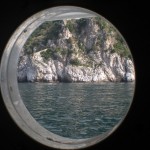
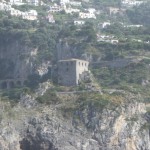
They were, after all, beautiful.
And we had a terribly entertaining deckhand.
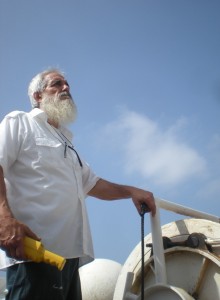
The approach to the island was fairly dramatic.
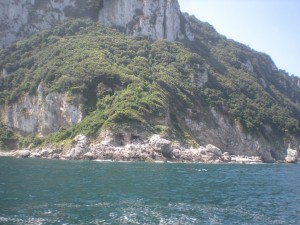
I find that cliffs make everything seem glamorous.
Capri is most famous for its “Blue Grotto,†a cave that emits a beautiful, blue light due to the light being reflected through the water and off of the limestone. We didn’t make it there.  Overhearing that the rough seas and mobs of tourists had made the entrance to the cave “hell†from a private guide who was talking on his cell phone to one of the boatmen at the cave, we decided that we’d forgo the trip out.
Instead, we opted to head up the side of the island via funicular. In fact, we decided to follow the guide and his two American clients. They seemed to have a plan that included a walk around the tip of the island, and some food. We like food. And we like local recommendations for food. So, we fell into stalking mode. I’ve been wandering around alone for long enough to be pretty good at following paid guides without actually paying. Yeah, it’s a skill I don’t usually brag about.
Knowing that we could catch them at the top of the hill, we bought our tickets and climbed aboard the funicular. Now, those of you who have watched Amazing Race will know what a funicular is. For everyone else, it’s a kind of wonky boxcar that takes people up the side of a hill/mountain. It’s at an angle. All of it. In order to keep people standing up straight, the car is strangely angled up , creating a Wonka-vator effect.
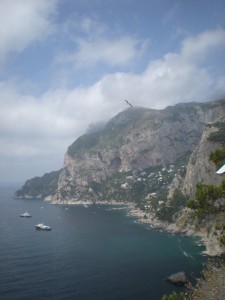
But by that time we were starving, and the Ant had to pee. A lot. After some coaxing, I approached our hijacked guide.
“Excuse me. It seems like you know this place pretty well.â€Â I’d had to interrupt after waiting a few minutes for a break.
“A bit.â€Â He smiled. His clients did not.
“Is there anywhere you’d recommend to eat?â€Â We couldn’t wait any longer to follow him into a restaurant.
“Hmm.â€Â He proceeded to take several minutes to tell me that the place he would usually recommend was closed on Wednesdays, and that there were plenty of places back down by the funicular. About 15 minutes hike back down the mountain.
“Thank you.â€Â I tried to act grateful and not irrationally frustrated. We’d followed him, on my suggestion, to a dead end at the top of a mountain. Fantastic.
If we had to walk back and start over, at least the view was pretty.
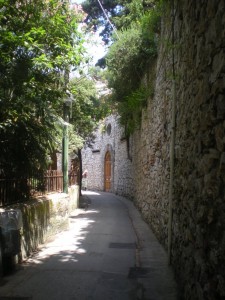
This part of the island seemed far less frequented than the rest. Quiet and unassuming, villas hid behind hedges and locals walked the streets.
We found our way back to the main square and headed into the Medieval part of town. I think we stopped at the first restaurant we found, grateful for a place to sit.
The white walls were hung with black and white pictures. A single-browed youth stood in a black apron, serving smiling celebrities. A young man with the same brow leaned in, smiling next to glamorous women. A man, with a shock of black hair embraced the customers as they posed together.
I looked up and noticed a man, with graying hair and eyebrows coming together in the middle standing against the wall next to the kitchen door. He surveyed the room. Not a celebrity in sight. Just a table of Japanese women and a couple of Americans, too exhausted to talk.
We ordered lunch, a couple of pasta dishes that were good, a cheese plate and desserts to match.

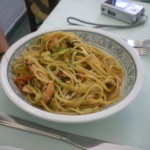
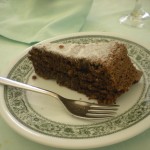
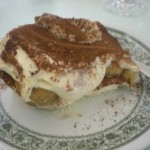
Then we headed back into the insanity to do a bit of shopping and snap some pictures with the rest of the crowd.
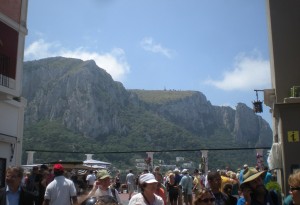
There were some beautiful parts of Capri. If I could squint my eyes, and vanish the hoardes, I could see how pretty it was. What had brought generations of royalty here.
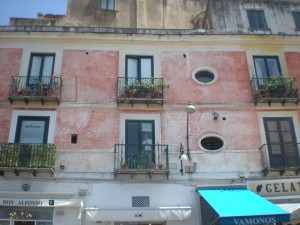
But it wasn’t sustainable.
We walked into a shop to buy a gift for my Grandfather. The Greek flag watch had caught our eye as we walked by. In Italian, we worked through the item, the price, and whether we could easily change the battery. As we went to leave, the woman behind the counter stopped me.
“Italiana?â€Â Seriously? She wanted to know if I was Italian? After a conversation in my broken language?
“No. Americana.â€
“Pero, parla l’Italiana.â€
“No, un poco.â€Â I seriously didn’t speak Italian. Only the littlest.
“Pronuncia bene.â€
“Grazie!†I beamed. Nobody had ever told me that I pronounced the language well. For someone who nearly worships words, this was a high compliment.
We smiled at each other and bid goodbye.
The next few hours were marked by a ride down the funicular, where we listened to a woman screaming at the attendants in an accented English and Italian mixture. I mused at the tiles in the station, thinking of her as the crazed barbarian, and us as the serene mountain goat.
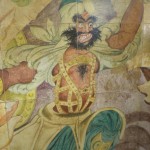
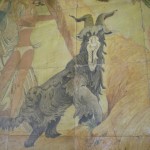
Once at the bottom, we purchased our tickets for the return boat ride, bought a couple of granite (slurpies) and camped on a little strip of beach to watch the piercingly clear water holding up the small boats that bobbed on its surface.
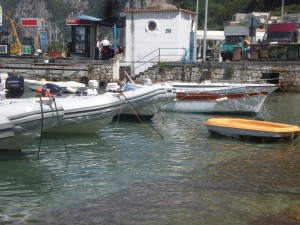
I even found some time to post a few items to the interwebs.
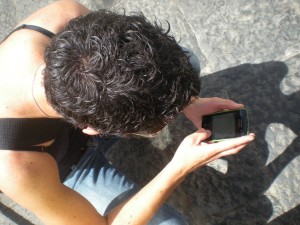
We were so ready to leave the little island that we boarded our boat 40 minutes early and watched, horrified, as ships from Naples unloaded still more people onto the protesting docks.
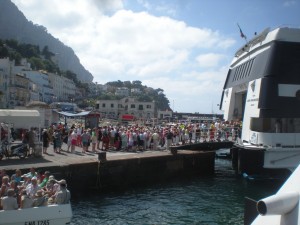
The ride back, however, was a delight. First, we were mistaken for – wait for it – Canadians! That’s right! Some lovely people behind us tapped us on the shoulder and asked if we were from the Great White North! Then they told us that Idaho was close enough. I like Canadians.
We spent the next two hours chatting with them about everything. They were lovely people who were just ending their 3 week trip to the country.
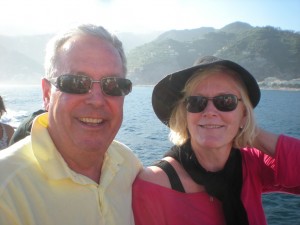
We took each other’s pictures and exchanged contact information. It is always a delight to meet new people, and Roy and MaryLou were extra delightful. After about an hour, Roy asked me a question about our President.
“I can’t tell your politics,†he said deadpan.
I laughed hard, and slapped him on the shoulder. I’m still not sure if he was kidding. I love Canadians. Have I mentioned that?
The second thing that made the ride back extra lovely was the light. It was absolutely stunning. Almost as if it was coming from under the water, shining up.
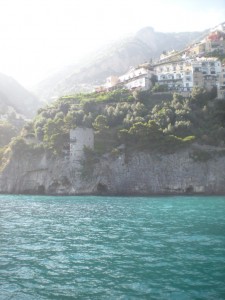
It made the lighthouses and jewel-like cities sparkle more than usual, and made the boats look like they were floating in air. Or Jell-O.
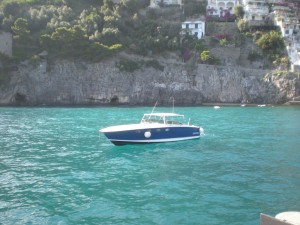
Even the docks were alive, sparkling like diamonds
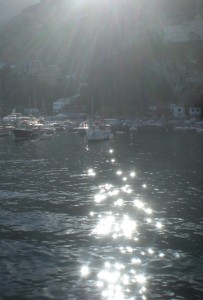
The docks.
Here’s the thing, we didn’t take off from the docs of Salerno.
Hmmm. As we pulled into the slip we realized our error. We were coming into a different port in Salerno. About 2K from where we should be. If there’d been an option, we would have taken it. But there wasn’t, so we walked. Through the streets, through parks, along the water.
And we reminded each other that, even though we were tired, and burned out from a long, exhausting day, life was beautiful. We were in Italy. And we’d just been mistaken for both Italians and Canadians.
Bella, eh?
July 2, 2010 1 Comment
Angels and pizzas
“Napoli e bella.â€Â We’d heard it pretty much every time we mentioned to anyone that we’d be in the south of Italy. At least from the folks in Italy. One of my good friends had spent time there, and she was also a big fan, but other than that, I’d heard that Naples was dirty, dangerous, and really nothing great. Still, “Napoli e bella,†echoed in our ears.
“I think we should do Naples.â€Â The Ant and I were planning our last week in the south. “I mean, our family is from there.â€
“Yeah,†she agreed. “If grandpa was here, he could tell us all about it.â€
On our trip to the north, we’d been hesitant to tell people where our family was from. Naples has a reputation, and Campo Basso, where my great grandmother was from, doesn’t seem to be much better. The usual response we would get was a, “mmmmm†and a changed subject. But here, far south of Naples, it seemed to be the crown jewel, a beautiful metropolis.
Our day started as it usually did, with a cappu, a pastry, and a ride on a bus.
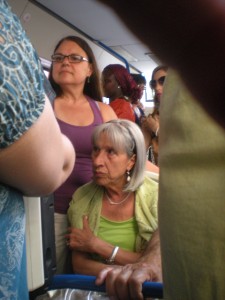
A pretty darn crowded bus.
Then a ride on a train. The a ride on a subway car. One that went from empty to packed in approximately 20 seconds.
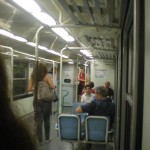
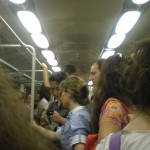
If Rome is the best of everything, Naples is the most of everything. It’s intense, like bone marrow cooked down to its absolute essence, earthy, pushy.
We were only spending one day in Naples, so we wanted to hit the highlights. Museum and pizza were high on the list. When we emerged from the subway, we were hot and disoriented. We’d watched a grandmother struggle aboard the car and, practically collapse into a seat that was quickly vacated by a hoard of giggling high-school aged girls. She fanned herself with a collapsible fan she pulled from her purse and muttered rapidly about the heat. The girls sat on each other’s laps to make room for her and rummaged in bags to find water to offer her.
Now, above ground, we were rummaging for our own water bottles, and I was looking for the “big, red building†that Rick Steves had described as marking the National Archeological museum. Now, Rick has done me very well in the north, but his apparent ignorance of/loathing of the south was starting to annoy me. (Yes, Frank you were right.)
As I looked up the street, up a hill, I saw at least 3 big, red buildings.
“Um, maybe it’s one of those,†I tried, gesturing feebly at them.
“Kristin!â€Â The Ant wasn’t amused. And I wasn’t even joking.
I shrugged, and we headed up, sweating freely in the midday sun.
It turned out that the museum was a fourth big, red building. Fortunately, it was closer than the others. After trying to enter a metro entrance marked “Museo,†we finally found our way inside. The museum is known to house many of the treasures that were stripped from Pompei when it was discovered. The frescoes and mosaics were cut out and removed to become part of the royal collection. I was most excited to see the mosaics and the “secret room,†a collection of erotic art commissioned by the wealthiest home-owners in Pompei.
Unfortunately, the mezzanine level, which houses both the mosaics, and the secret room was closed. No erotic art for us. Well, kind of.
We entered the galleries and began our appreciation of the art.
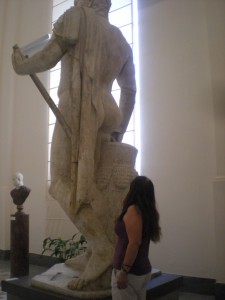
The Ant really had a deep understanding of the Farnese gallery. I think it was the fine relation of the human form that captivated her.
I, on the other hand, identified with the “labrys-bearer,†and “fish-wrangler†as I like to call them.
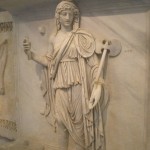
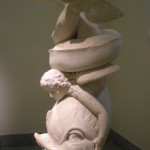
Starting to get hungry, we ran through the collection of frescoes and tools.
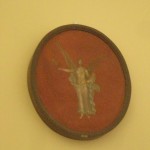
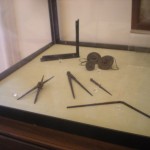
And then checked out the sundial room, which, at noon every day, shows the date with a single shaft of light thrown onto the calendar on the floor.
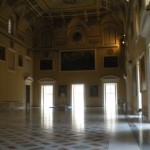
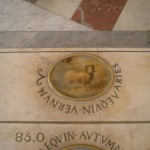
Finally, we headed into the room of Greek sculpture. From the first time I looked into the stone and bone eyes of the Greek statues in Athens, I’ve felt an affinity with these objects. A near kinship. When I look into the faces of Roman marble busts, I don’t see myself. When I look into the eyes of the Greeks, I do.
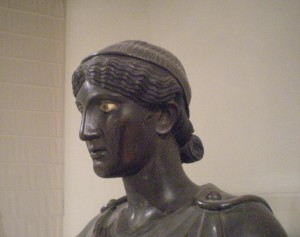
Also, their asses.
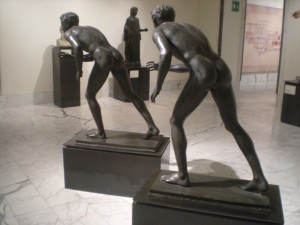
And then we saw a really fascinating modern exhibit. One with Medusa.
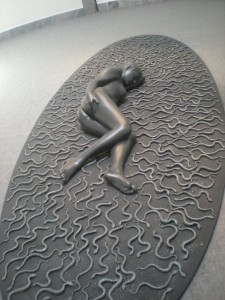
I once went for Halloween as Medusa. You know what they don’t tell you in the US? She’s Intersex.
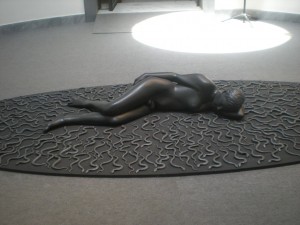
No, really. It’s part of the myth. It just gets left out. Fascinating. I might have modified my costume a bit.
After Medusa, we were able to cross the museum off our list. All that was left was pizza. Pizza. In Naples. Rick had not been super helpful thus far, but he did have the names and locations of two famous pizza places listed in his Naples section. I somehow convinced the Ant that it was necessary to eat at one of these two restaurants. And also that I’d be able to navigate us through the streets of Naples to them. Fortunately, they were across the street from each other. And so we started walking.
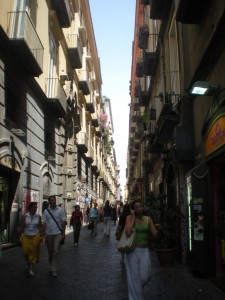
There were a lot of people. And a lot of shops. And a lot of cars and scooters, and flags waving.
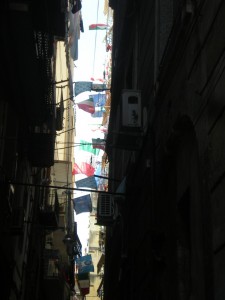
There was a lot of gum on the sidewalk. There was a lot of graffiti, too.
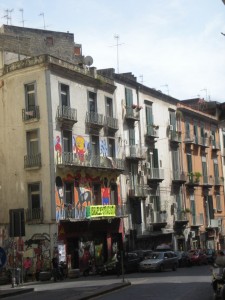
“Dirty†is the way I heard it described. In guidebooks, from other tourists, and from the people we met at lunch.
“She thinks it’s dirty.â€Â The couple next to us was visiting. She from Madrid, he from Rome.
“I like it,†I said. Not as though I was trying to be contrary. Naples really had a feel to it. Unsettled, seething – but interesting.
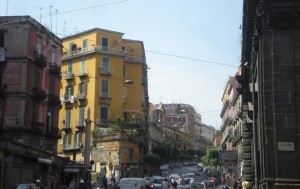
“Earthy.â€Â That’s the word I applied to the city. Maybe the word I’d apply to myself. Not sure.
“How do you eat so much.? Magra.â€
“He says you’re so skinny.â€Â The woman was translating the Italian to English. Beautiful. And he spoke to her in Spanish.
I smiled. The Ant and I had just polished off two pizzas. Two pizzas that turned out not to be ours.
In the bustle of the upstairs pizza parlor, the din that rose from the family-style tables crammed together, someone had misunderstood. When they set the two pizzas in front of us, I wondered. Then I pretended that they were two different types – our types:  margherita and 7 cheese. I even swapped with the Ant. Then we traded pieces, willing our taste buds to experience the 7 different cheeses. Yes, we were that hungry.
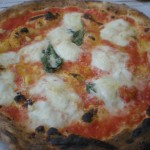
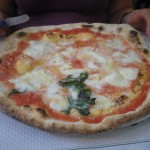
As I gobbled, I thought about the other people who might be equally hungry, waiting for pizzas that wouldn’t come. There were people inquiring about pizzas everywhere. This seemed a common issue. And then the third pizza arrived.
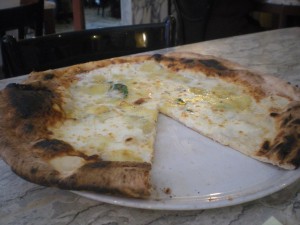
This was what a 7 cheese pizza was supposed to look like. Ahem.
The waiter looked at our neighbors who told him we’d already eaten. He shrugged and smiled and left us the pizza.
Our new friends looked at us. The people on our other side stared.
“I’ll share!â€Â I declared. They all waved their arms, distancing themselves from the fugitive pizza.
When we left the restaurant, it was with a pizza box under my arm. There was no way I was going to let that thing go to waste.
“You’re going to carry that through Naples and on the train back to Salerno?â€
“Yes, but if I find someone to give it to, I’ll do that,†I told the Ant.  She agreed.  In Portland there would be a dozen street kids asking for it the second I left. But here, I ran into nobody who was even asking for money. I found this odd in a city as earthy as Naples.
Walking back toward the museum and the metro stop, we ran into our friends Andrea and Irene from the restaurant. We chatted about the city, and exchanged contact information. Andrea told us not to show our cameras or money in the street. Then we continued on, taking in the glory of the city.
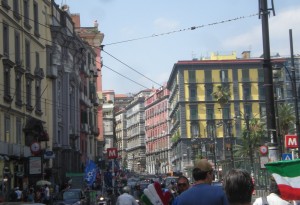
The Ant didn’t so much share my love of Naples.
The day was just getting hotter. Thinking of the crammed train ride ahead of us, we bought a bottle of water, found a park bench, and hydrated. Then I grew a little restless.
“It’s time to move,†I said to the Ant. It just felt like we’d been on that park bench a little too long.
When we stood up, a scruffy, bearded man put out his hand and asked for money.
“Una pizza buona?â€Â I asked, handing the box to him.
His face lit up. “Si. Si! Buona.â€
“Ciao,†I said and we walked along toward the station, past several big, red buildings.
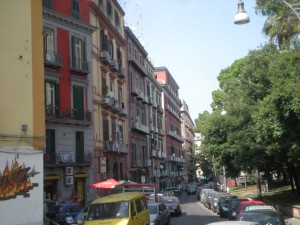
That night I had an email from our new friend.
“Kristin, you didn’t eat too much pizza?†came the Italian question.
“No, don’t worry. I gave it to a man on the street.â€
“Well, then he surely saw an angel today.â€Â I loved that he thought of a woman with pizza as an angel.
Do you see why I love Naples?  A place where graffiti artists compete for your attention with fascist architecture, and angels walk the streets doling out pizza. This is my kind of earthy. Napoli e bella.
July 1, 2010 1 Comment

